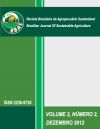COMPARISON AMONG METHODS OF RISKS OF FIRES BY INDEXES OF HAINES, ANGSTRÖM, MONTE ALEGRE AND HIGROTERMOMETRIC IN THE REGION OF VIÇOSA-MG, IN THE PERIOD FROM 01 TO 30 OF SEPTEMBER OF 2003
DOI:
https://doi.org/10.21206/rbas.v2i2.179Abstract
Various methods were developed to indicate the development of fires. All have their own procedures and particularities, but all methods depend on the surrounding atmospheric conditions and weather data. The basic principles are: high temperatures and low humidity and rainfall, in which these parameters are associated with great chances of uncontrollable and accidental fires. There methods are non cumulative and cumulative, in which non cumulative methods are based only on the current weather conditions on the day, as the risk factor of Angström. Cumulative methods consider climatic conditions of a succession of days, as for example: Monte Alegre formule, Higrotermic Index and the Haines index. So, all these indexes will be compared to determine which of these methods would have greater order in relation to the development of actual fires. Burning and forest fires cause, additionally, costs and environmental degradation and negative factors for society as a whole. One of the main effects is to release significant amounts of carbon into the atmosphere by burning biomass plant that contributes to global warming, better known as the greenhouse effect. Each year, worldwide, forest areas equivalent to the territory of Portugal are destroyed. This study aims to indicate which is the best method for risk management and monitoring of forest fires for Brazil, which will be used to bounce the 25 day of September 2003, as a case study because it was considered to be more critical of the burned and fires during this month and will also be studied methods during the entire month, having as objective the comparison of methods for the municipality of Viçosa-MG. The values indicated by particular variations will demonstrate each method. The oscillation between the methods will provide help in the critical areas of management and strategic decision-making for fire control, as well as to verify the behavior of each method, aiming at individual behavioral and descriptive results of burning, so that later may occur operationally the control and management of this phenomenon and indicating the best method.Downloads
Download data is not yet available.
Downloads
Published
2012-12-01
How to Cite
Carlos Fernando Lemos, Flávio Justino, & Hygor Aristides Rossoni. (2012). COMPARISON AMONG METHODS OF RISKS OF FIRES BY INDEXES OF HAINES, ANGSTRÖM, MONTE ALEGRE AND HIGROTERMOMETRIC IN THE REGION OF VIÇOSA-MG, IN THE PERIOD FROM 01 TO 30 OF SEPTEMBER OF 2003. Brazilian Journal of Sustainable Agriculture, 2(2). https://doi.org/10.21206/rbas.v2i2.179
Issue
Section
Artigos
License
1. Proposta de Política para Periódicos de Acesso Livre
Autores que publicam nesta revista concordam com os seguintes termos:
Autores mantém os direitos autorais e concedem à revista o direito de primeira publicação, com o trabalho simultaneamente licenciado sob a Licença Creative Commons Attribution que permite o compartilhamento do trabalho com reconhecimento da autoria e publicação inicial nesta revista.











